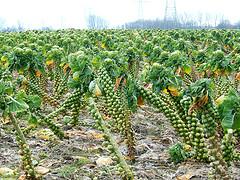Brussels sprouts
| Infobox on Brussels sprouts | |
|---|---|
| Example of Brussels sprouts |  |
| Freshness facts | |
| Optimum carrying temperature | 0°C |
| Highest freezing point | -0,8°C |
| Acceptable product temp. at loading into containers | Max. 2°C above carrying temperature |
| Optimum humidity | >95% |
| Ventilation setting for containers | 60 m³/hr |
| Storage life | 3-5 weeks |
| Climacteric / non-climacteric | Non-climacteric |
| Ethylene production | Very low |
| Ethylene sensitivity | High |
| Modified / controlled atmosphere | 3% O2; 6%CO2 |
| Potential benefits | Slight |
| Availability | |
| South Africa C. America N. America N. Europe Netherlands |
On demand February - March March - April September - March September - February |
Brussels sprouts
Contents
Harvesting and Handling
Good quality Brussels sprouts should be bright green, without yellowing or discoloration, and have a firm texture. The butt end may be slightly discoloured, but should not be dark. Brussels sprouts should be sweet and mild in flavour when cooked. Bitterness varies among cultivars and is associated with high concentrations of specific glucosinolates (sinigrin and progoitrin). Bitterness can also be induced by storage conditions.
Film packaging is useful in preventing moisture loss because transpiration by Brussels sprouts is high even if the relative humidity is kept at the recommended level. The film should be perforated because accumulated volatiles other than carbon dioxide produced by the Brussels sprouts result in objectionable odour or flavour and because a build-up of 20% CO2 in the atmosphere can cause injury.
Cooling and Storage
Brussels sprouts are moderately perishable and can be stored 3-5 weeks at temperatures near the optimum of 0°C with >95% RH. Shelf life at 5°C is 10-18 days and at 10°C is less than 7 days. Brussels sprouts are often hydro-cooled, but can be air cooled as well. Although they have considerable wax on their leaves, they become flaccid due to water loss if high relative humidity is not maintained.
As with broccoli, sufficient air circulation within the storage container(s) is desirable to allow good cooling and to prevent yellowing and decay. Also Brussels sprouts should not be stored with fruits because ethylene from the fruits will accelerate yellowing and can cause abscission of leaves.
Brussels sprouts freeze at about -0.6°C. Slight freeze damage on the outer leaves of buds may result in small dark and translucent areas. Severe freeze damage results in the entire bud becoming dark and translucent, and very soft after thawing. Brussels sprouts are not sensitive to chilling temperatures and should be stored as cold as possible without freezing.
Controlled atmosphere considerations
Brussels sprouts can be benefited by 1-4% O2 with 5-10% CO2 atmospheres at 2.5-5°C. The main benefits are reduced yellowing and decay, reduced butt discoloration and inhibition of ethylene production. No benefits of CA are observed if the Brussels sprouts are kept at their optimum storage temperature 0°C. Low oxygen storage (<1%) can cause extreme bitterness and may also cause internal discoloration. Atmospheres of 10-12% CO2 can result in off-flavours and off-odours.
Storage disorders
Alternaria rot, Bacterial rots, Black rot, Cercosporella spot, Downy mildew, Grey mould rot, Light leaf spot, Mosaic virus, Powdery mildew.











